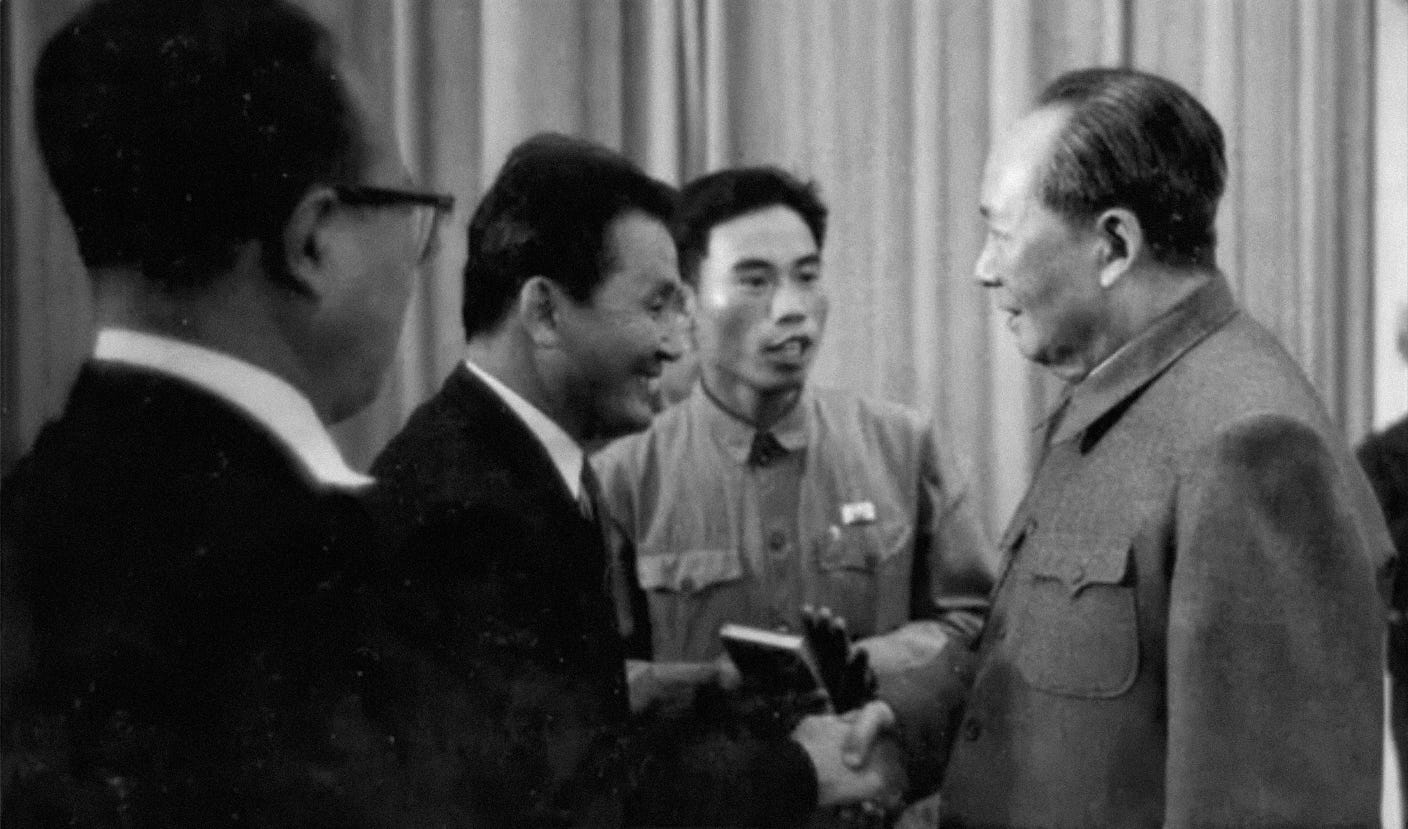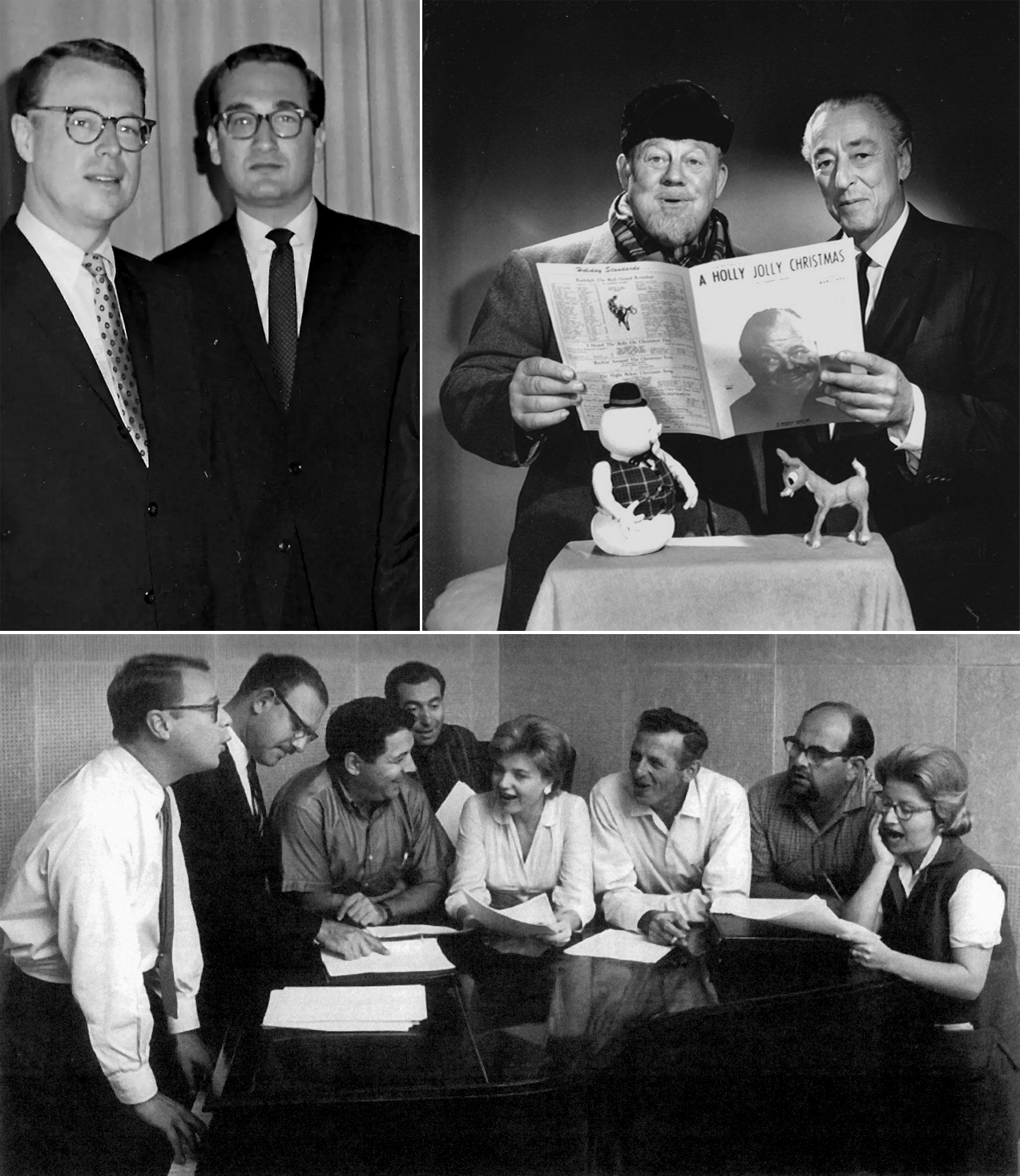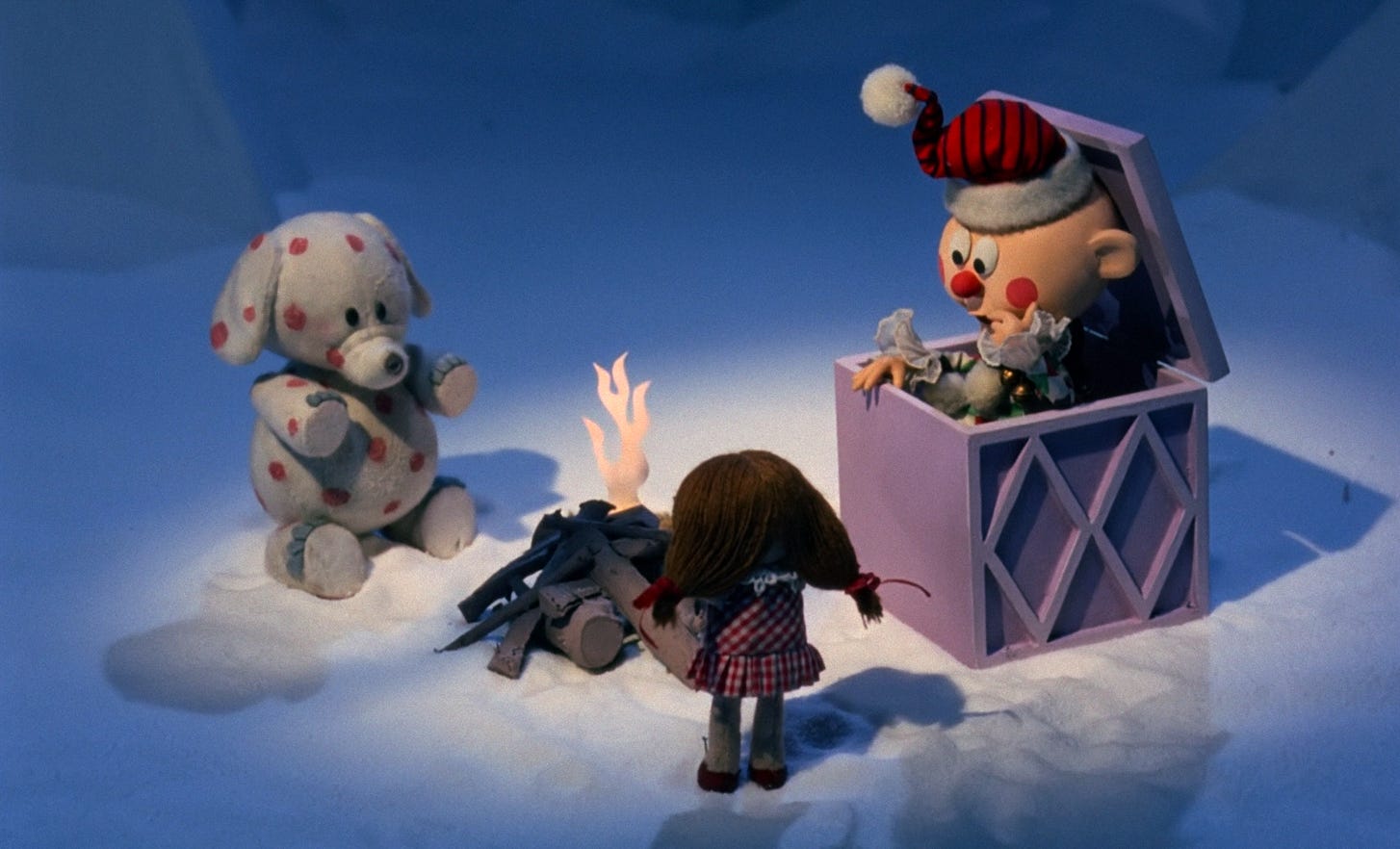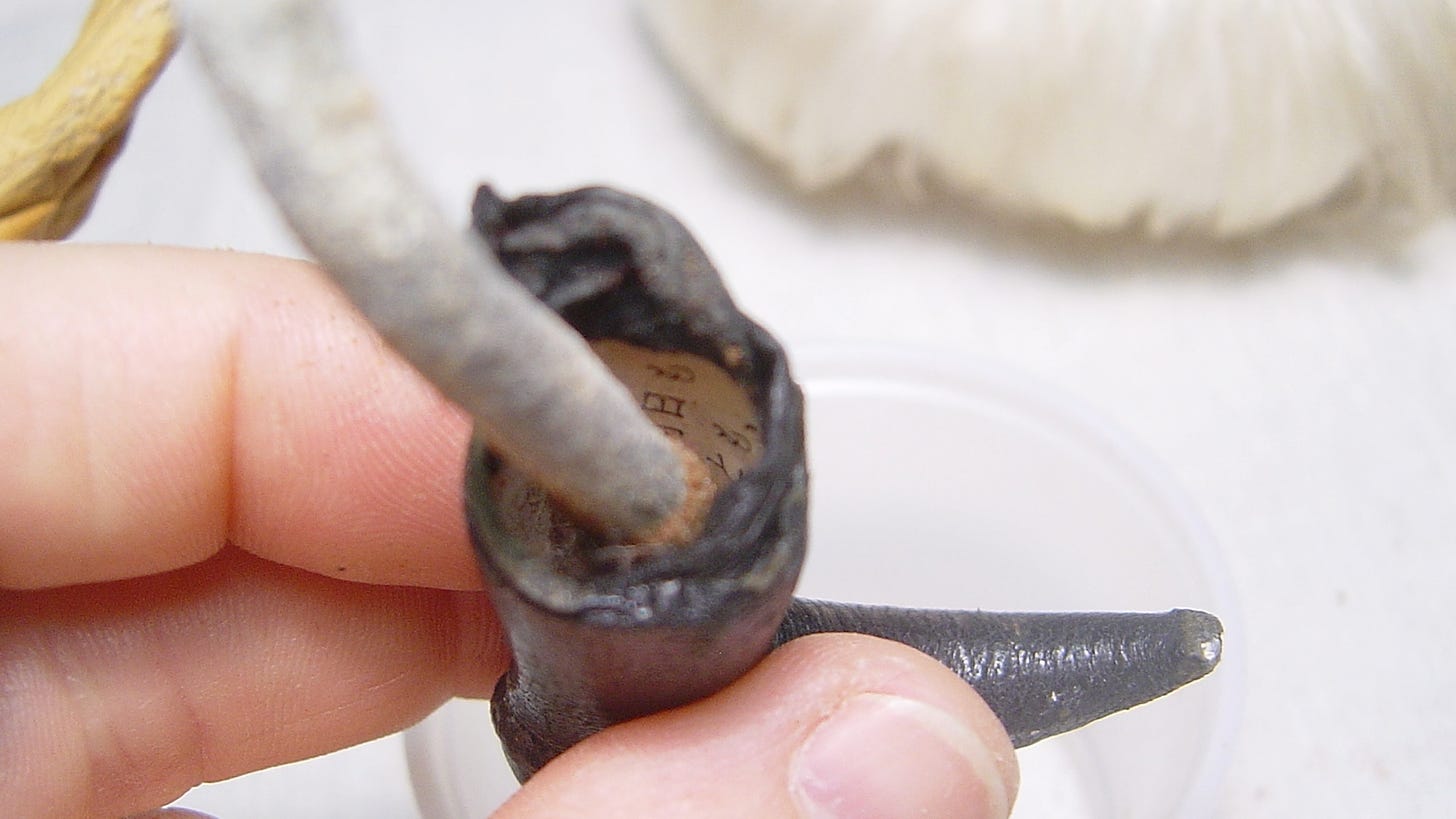Welcome! We’re back with another issue of the Animation Obsessive newsletter. Here’s the plan:
1️⃣ Tadahito Mochinaga and Rudolph the Red-Nosed Reindeer.
2️⃣ Global animation news items.
3️⃣ [UNLOCKED] A bizarre ad by Studio Ghibli.
If you haven’t already, it’s free to sign up for our Sunday issues. You’ll get them in your inbox, weekly:
Let’s go!
1. Rudolph, made in Japan
Since its premiere in 1964, Rudolph the Red-Nosed Reindeer has stayed a Christmas classic. You’d think that 58 years would be enough to make its charming design and strange sense of humor go stale, but no. It remains quirky, fun TV.
But there’s a unique fact about Rudolph, tied to its creation. The kind of fact that’s famous enough to inspire did-you-know articles every December — but obscure enough that those articles surprise a large audience each time. The fact is: Rudolph was outsourced to Japan. Its concept, songs, voices and storyboard came from America and Canada. The animation and puppets were done in Tokyo.
Back then, outsourced animation was booming for the first time. Rocky and Bullwinkle had been animated in Mexico a few years before. Tom and Jerry got shipped off to Czechoslovakia in the early ‘60s. The outsource artists on these productions were a diverse, unexpected bunch, who had their own views about the situation.
Yet maybe none were so unexpected, or so fierce in their views, as Tadahito Mochinaga — the leader of Rudolph’s animation team in Japan. At the time, he was a member of the Japanese Communist Party. His ties to Maoist China were close, and his opinion of America’s influence was low. According to historian Daisy Yan Du:
Sympathetic to Chinese and Soviet filmmaking, Mochinaga was critical of American filmmaking. Hundreds of American films were imported in postwar Japan every year, and were very popular among Japanese audiences. For Mochinaga, most of the imported American films were about imperialism, war, police, crime, gangsters and racism. … Full of irrationality, madness, killing and sex, Mochinaga called American films “sugar-coated bullets and bombs,” a term borrowed from Chairman Mao.1
But Mochinaga found himself making all-American animation for Western TV. How?

That story is a winding one. It’s important to understand that Tadahito Mochinaga was among the most influential artists ever to work in animation. He’s also among the most complicated. On one hand, his time on Rudolph was an anomaly — on another, it made total sense.
Born in Tokyo in 1919, Mochinaga studied animation in art school, inspired by Disney. He started working on cartoons funded by the Japanese government. Then things took a turn. “As World War II broke out in the Pacific,” wrote Daisy Yan Du, “Mochinaga began to produce animated propaganda films for the Japanese Navy.”
He was doing the work in front of him. At the time, that meant animating for one of the 20th century’s most extreme right-wing regimes. His contribution to the popular and influential film Momotaro’s Sea Eagles (1943) came to haunt him. As he later wrote:
I heard that many youths volunteered for the flying corps and that while they were on duty they died on air raids. I wonder whether the film that we made influenced their decision to volunteer ... I thought, in the future I only wished to make a film that would benefit the young, difficult though that might be.
As World War II raged, Mochinaga’s home in Japan was destroyed. His health was deteriorating. And so, in June 1945, he and his family went to live in China — seeking better conditions in an area occupied by the Japanese.
Doing the work in front of him again, Mochinaga got a job at a local film studio. He started to animate. Less than a month later, things took another turn. “Japan’s defeat … took us by complete surprise,” Mochinaga’s daughter Noriko wrote a few years ago. “It meant that we ended up getting caught up in the Chinese Civil War, between the nationalists and communists.”
For Mochinaga and his family, the end of World War II was only the start of a new period of chaos and terror. But his animation skill was rare in China, and he stood out. Within a few years, he was making animated propaganda for the communists against the right-wing faction — venturing into puppet animation for the first time, and breaking ground in China. Here, he developed his skill for stop-motion.
Mochinaga only stayed in China until 1953, but he helped to lay the foundations for Chinese cartoons as a whole. The camerawoman who pioneered ink-wash animation later called him “my first teacher.” Another artist from Shanghai Animation Film Studio wrote:
… it’s important to express the studio’s thanks to Comrade Fang Ming (Tadahito Mochinaga’s Chinese name), who nurtured the talent at the studio. If we hadn’t had Comrade Fang Ming to support us back then, it is debatable whether we would have reached such a high point today. I don’t know what would have become of our animations.
Mochinaga’s career by this time had been so wild, so big and so dangerous, it’s impossible to summarize it cleanly. But he returned to Japan as a talented filmmaker, and as a stop-motion artist. Which would lead to Rudolph.

Mochinaga didn’t want to work in outsourcing. It was never part of his plan. But he ended up with little choice — and he did the work in front of him, once again.
He was running an animation studio in Tokyo, specializing in stop-motion. In the mid-to-late-1950s, it came onto the radar of American producer Arthur Rankin, who recalled that Mochinaga’s “storylines and subjects were solely for Japan and not suitable for export but the technique, based on the Japanese puppet art of Bunraku, was good.”
Mochinaga was directing films like Bunbuku Chagama (1956) and The Fox That Became the King (1959), with soon-to-be legendary talents like Kihachirō Kawamoto in his stable. Rankin was right: the technique was excellent. It has the charm of Rudolph, only a bit more polished. But money was scarce. Mochinaga’s studio closed soon after The Fox.
When Mochinaga reformed with a new studio, co-founding MOM Productions, his partners insisted on working with the Americans. Arthur Rankin and Jules Bass wanted to do a stop-motion show called The New Adventures of Pinocchio (1961). Mochinaga “opposed taking this outsourced project,” wrote Daisy Yan Du, but ultimately relented with an agreement that it would be MOM’s only job for an overseas company.
Yet the jobs kept coming. Coupled with a devastating studio fire, MOM ended up stuck: “the studio suffered a huge financial loss, which meant accepting more outsourced projects,” Du wrote. Mochinaga became dependent on Videocraft International (Rankin/Bass). And soon came Rudolph the Red-Nosed Reindeer.
Rudolph was a big, lavish, expensive project by the standards of American TV. A Charlie Brown Christmas (1965) cost around $96,000 — yet the overall budget for Rudolph was roughly $500,000, or over $4.8 million today.
That money wasn’t all for Japan, but MOM still got paid. According to Mochinaga, the studio was given 18 million yen to make Rudolph, and production costs totaled only 13 million. By contrast, Osamu Tezuka famously budgeted Astro Boy at 550,000 yen per episode around the same time. That’s under $20,000 today.
Working with Rankin and Bass had paid off — literally.

But Rudolph wasn’t easy, either. According to Daisy Yan Du:
The working hours were so long that animators slept at night in the studio near the puppets. To save time and cost, each puppet character had several duplicates so that different animators could work on different scenes with the same characters simultaneously. … MOM developed a style of “limited” puppet animation for American television productions in the 1960s, the same time that Osamu Tezuka introduced limited cel animation to television in Japan.
The herky-jerky motion of Rudolph is endearing, but not as subtle or polished as the best stop-motion animation from places like China or Czechoslovakia at that time. Still, Mochinaga and his team brought a special appeal to it.
Animator Hiroshi Tabata remembered that the staff spent two days visiting Nara Park, famous for its deer, to “build up our imagination of Rudolph and the reindeer’s world in the bosom of nature.” According to lead puppet designer Ichiro Komura:
Our puppet-making team and set & prop team were the first groups to start the production a few months ahead of the shooting. First, I made a solid and animatable design of the puppets. It’s a full-scale design of each puppet in the show. I decided costume color coordination after consulting with the set designer, because the basic costume color should not be the same basic color of the set.
I used Katura tree wood for the head of the puppet. First, I sawed through the profile of the puppet with a coping saw and carved it with Japanese chisels to make the head. The head weight of the puppet must be light. If the puppet’s head was big, I dug inside of the head and made it light.
According to Rankin/Bass historian Rick Goldschmidt, Rudolph’s puppets each “cost up to $5,000 to construct.” They were makeshift. Restorer Robin Walsh later noted signs of candle wax and Play-Doh inside Rudolph’s head, around his nose. Snippets of a Japanese newspaper were stuffed into Santa’s boots. Each puppet had a small range of motion: it was “truly what it needed to be, and nothing more,” Walsh said.
“The Animagic figures would last about 16 months, tops,” Jules Bass later remarked. For reference, Rudolph was an 18-month project. Few of the original puppets survive today. But they got the job done.
Mochinaga never warmed to outsourcing for the Americans. He called these “the days of hard battle and bitter fights.” On a visit to China in the ‘70s, he told artists to think twice before taking outsource work. These projects taught animators to ignore their own culture, he said, and the influx of foreign money had a distorting effect on the local industry.
And yet, as Daisy Yan Du noted:
… from a longer-term and more positive perspective, working on outsourced projects trained many talented Japanese animators and earned revenue that kept the studios and the entire animation industry alive, which contributed to the rise of Japanese animation on the global stage in the late 1980s and 1990s.
Mochinaga’s work for the Japanese government had helped to establish Japanese cel animation. His work for the communist faction (and, later, government) in China had changed the course of that country’s animation. And his return to the now-capitalist Japan, to make TV shows and specials for the Americans, had brought stop-motion films to a broader audience and buoyed Japanese animation as a whole.
“Tad Mochinaga,” as he was credited on Rudolph, was now one of the world’s most influential animators — almost by accident.
Plus, although Mochinaga was unhappy with the Rudolph arrangement, his team didn’t necessarily share that view. Rudolph was difficult, but it wasn’t hell. And the work had value. Ichiro Komura, the puppet designer, later said:
Personally, I liked Rudolph the best among Rankin/Bass shows because it’s simply a good movie. It’s filled with tenderness and has a heartwarming story in it. I believe Rankin/Bass shows made a great contribution to Japanese puppet animation and I appreciate Mr. Rankin very much. Most of my staff who are working in puppet animation in Japan now had experience and got influenced by Rankin/Bass shows. I wish I could work for another show like Rudolph again, and I believe many of my colleagues think the same way.
2. Newsbits
We lost George Newall (88), the co-creator of Schoolhouse Rock.
In America, the Oscar longlist for animated features is out. In the running are films like My Father’s Dragon, Marcel the Shell with Shoes On and Pinocchio. We’ll see what makes the shortlist. Turning Red and The Sea Beast are likely shoe-ins.
Speaking of Pinocchio, it hit Netflix on Friday. In America, it’s been one of the hyped animated films of 2022 — having seen it now, it’s easily one of the most unique. Check out the film and then this making-of piece by AWN.
It’s come to our attention that American animator Nancy Beiman (Hercules, Treasure Planet, A Goofy Movie) is writing an animation newsletter on Substack. Very exciting.
The Taiwanese miniseries Iron Farmer (about a robot that gardens) generated buzz in its home country this week. It’s gotten noticed at international festivals — see a trailer.
In China, the hotly anticipated Three-Body Problem animated series debuted its first two episodes on Bilibili this week, quickly drawing 95 million views. As of this writing, its page lists over 120 million views.
Also in China, One Piece Film: Red hit #1 at the box office, raking in more than $10 million across four days. (Red is blowing up in South Korea, too.)
Russia’s state-run Cinema Fund unveiled its next round of animated projects. It seems the feature Ekspeditor by Anton Dyakov, known for the Oscar nominee BoxBallet and for criticizing the invasion, isn’t on the list. (Meanwhile, Russian theaters that illegally show Western movies have reportedly agreed not to screen Avatar: The Way of Water until January, to give local films a chance.)
Another American story: production workers at Nickelodeon Studios have voted to join The Animation Guild.
Lastly, the Children’s & Family Emmys are coming out, with major awards going to City of Ghosts and Maya and the Three — and individual achievement prizes to Craig McCracken and Chris Tsirgiotis for their work on Kid Cosmic.
3. Retro ad of the week
This might be the newest “retro” ad we’ve featured in this column. But we feel it’s just old enough to count.
The commercial is from 2009, and Studio Ghibli made it for the Yomiuri Shimbun — Japan’s largest newspaper. Bubble Gumski Edition is likely the closest you’ll get to rendering its title in English. Basically, though, it’s untranslatable.
That untranslatability comes from the source material. In this spot, Ghibli animated the work of Shigeru Sugiura, a surrealist manga artist popular in postwar Japan. He was known for nonsense humor and strange drawings. He sometimes named his characters after objects — simply tacking on -suke (a common suffix for boys’ names) to the end. Hence Fūsen Gum-suke, the bubble-blowing ninja. Localized: Bubble Gumski.
This commercial is just 15 seconds long, and it “contains no corporate message,” as the Yomiuri Shimbun itself admitted. It’s weird, hilarious and very faithful to Sugiura’s style, which is about as far from the perceived “Ghibli style” as it gets. Besides Bubble Gumski, a host of Sugiura’s other characters make cameo appearances.
Goro Miyazaki directed Bubble Gumski Edition, but Sugiura’s ties to Ghibli run deep. Producer Toshio Suzuki, who pitched this ad to the Yomiuri Shimbun and forced the issue when the paper declined, is a longtime fan. Isao Takahata borrowed heavily from Sugiura in Pom Poko. And Hayao Miyazaki, who planned the ad, has been a Sugiura admirer since childhood — he’s taken a lot from him.
It goes back even to Miyazaki’s Future Boy Conan and Castle of Cagliostro in the ‘70s. Suzuki tells the story that, after seeing Conan for the first time, he noticed Sugiura’s influence in the third episode. He later mentioned it to Miyazaki, who was overjoyed. “You’re the first person I’ve met who understands this,” Miyazaki told him.2
Bubble Gumski Edition is credited as the first animated collaboration between Hayao Miyazaki and Goro Miyazaki. It came on the heels of the contentious Earthsea era — you can view this ad as a thaw. The Miyazakis were among the only people involved.
Which ties into the question of who animated it. He’s credited as “Kamon Oba.” This is a pseudonym — when read aloud in Japanese, you get something like “total idiot.” His real name is a secret. One Ghibli document hints only that he’s “an exceptionally skilled animator and one of the most indispensable people in Ghibli feature films.”3
Some on the Japanese side of the internet have debated this mystery in recent years, raising an idea that fascinates us: what if it’s Hayao Miyazaki? The little bird at the end feels almost like a signature — it has that staring eye Miyazaki uses. Plus, who better to animate Sugiura’s characters?
Still, whoever animated it, Bubble Gumski Edition is a must-see. It’s among the most unusual things Ghibli’s made, and we’ve rewatched it dozens of times without getting tired of it. Just seeing it move is entertaining, and the scrambled voices and abstract sound effects are a joy. You’ll find it with English subtitles below:
See you again soon!
From Du’s book Animated Encounters, our main source for the article. The direct quotes from Mochinaga’s memoirs, alongside other key details, come from Anime: A History. Rick Goldschmidt’s book on the making of Rudolph, and the book Chinese Animation and Socialism, supplied most of the other quotations and information. A final source was Restoring the Puppets of Rudolph, a Blu-ray extra.
Suzuki told this story back in 2014. He’s been discussing Sugiura’s influence on Miyazaki for years, though — citing his impact on Cagliostro in 2008. One giveaway, Suzuki said, is how Miyazaki portrays “the legs of two people running side by side.”
From the booklet to the Blu-ray collection Ghibli ga Ippai Special Short Short 1992–2016, an important source. (The booklet clarifies that the “Kamon Oba” who animated this ad isn’t the same “Kamon Oba” in the credits for Goro Miyazaki’s From Up on Poppy Hill. That, for the record, was Yôji Takeshige.)





Re: the -suke name suffix
Gus Mager was another artist who did something like this, but in early 20th century America. His comic strips Henpecko the Monk, Sherlocko the Monk, Knocko the Monk, etc., were very popular bits of comedy. Beyond potentially giving the Marx brothers their naming scheme, you can directly trace the origin of the English trend of turning adjectives into nouns by adding -o as a suffix. Weirdo, fatso, that kind of thing.
So another feasible translation would be Bubble Gummo.
An amazing story, as complicated as the times would come and allow.